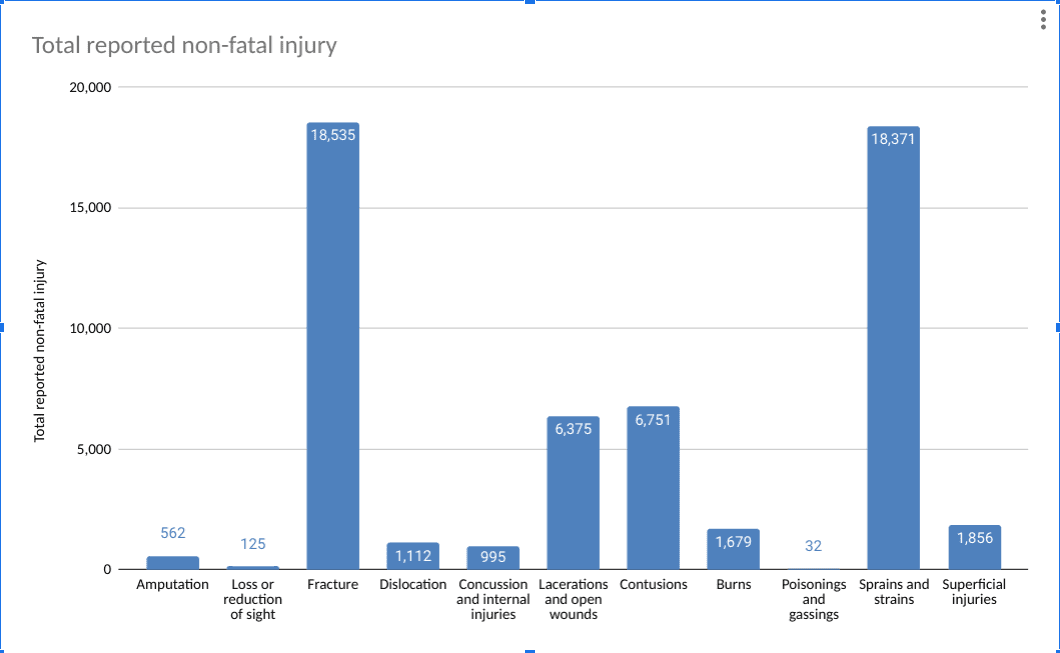By Jo Anderson. Last Updated 18th August 2023. Welcome to our guide to tendon injury at work claims. A tendon is a connecting tissue between your bones, muscles and other tissues in the body. They give us the ability to move and are vital in maintaining our health and mobility.
Tendons can be found in different places all over our bodies, and though built for use over the course of our whole lives, they are vulnerable to damage through overuse or injury through an accident to office workers or manual labourers alike.

Tendon injury at work
Sometimes it is possible for a person to get a tendon injury at work, through an accident, damage from a faulty machine, or other means. When an accident happens, it can be through the fault of the person who is injured, but it can also be through the fault of the employer.
If you experience a tendon injury in the workplace, and it was caused by the negligent behaviour of your employer, it may be possible for you to make a claim for compensation for your injury or any related financial costs.
Here at Accident Claims, we are committed to giving the best advice to anyone who approaches us about personal injury claims, and we have put together this article to give the basic information on making a claim for a tendon injury at work.
We have even included a personal injury claims calculator towards the bottom of this article to help you get an idea of the common compensation award for this type of injury.
If you don’t find what you are looking for in this article, our team could give you any other information you might need, and you can reach us on 0800 073 8801. Alternatively, you could use our online contact form to schedule a time for us to call you back.
Select A Section
- What Are Tendons And How Are They Injured?
- What Is A Ligament Injury?
- What Are The Major Tendons?
- What Could Cause A Work-Related Tendon Injury?
- Examples Of Types Of Tendon Injuries
- Tennis Elbow Injuries In The Workplace
- Flexor Tendonitis And Tendinopathy Injuries
- Tendon Injury In The Workplace Compensation Calculator
- No Win No Fee Claims For Tendon Injuries In The Workplace
- Why Choose Our Team To Handle Your Claim?
- Contact Our Claims Team About Tendon Injury At Work Claims
- Essential Resources Relating To Tendon Injury At Work Claims
What Are Tendons And How Are They Injured?
Before we look at how to make tendon or ligament injury at work claims, let’s first take a look at what these injuries are.
Looking a little more closely at the anatomy of the tendon makes it easier to understand the various possible injuries and how they can happen. Tendons are the fibrous connecting tissues that allow the muscle to tense up, pulling and pushing the bones they are attached to. They let us move around and are vital to our overall mobility and health. A tendon is made up of stretchy but inelastic fibrous collagen.
Tendons and ligaments are similar, but their purpose is different, as a tendon binds muscle to bone, allowing movement, whereas a ligament connects bone to bone, providing stability in joints, as well as supporting and securing the position of certain organs.
A tendon is made of strong tissue, but they are prone to injury from overuse or through an accident such as an achilles tendon injury at work from a trip or fall. Tendon damage can come in different forms, such as an outright tear, a partial tear, tendonitis, a strain, etc., and there can be many reasons why they become injured, such as overuse or through direct damage caused by an accident.
What Is A Ligament Injury?
In the last section of our tendon injury at work claims, we had a look at a tendon vs a ligament and established that they are similarly composed but used for different purposes. When a tendon is damaged, it can be referred to as a strain, but when a ligament is damaged, the common term to describe it is a sprain.
Accidents, such as a torn ligament at work, can be caused by overstretching them or directly damaging them in an accident. Sprains more commonly occur as a result of a sudden injury rather than through overuse. When a ligament is damaged, it is broken up into three categories depending on severity, with grade one being overstretching and three being an outright tear. Damaged ligaments present with similar symptoms to tendons, such as swelling, pain and bruising, but unlike tendons, a torn ligament will leave a joint unstable, loose and unable to bear weight.
What Are The Major Tendons?
The body has many different major and minor tendons that connect our muscles to our bones, allowing us to move around. To give you an idea of where possible injuries could occur and the subsequent tendon injury at work claims that could be made for them, we have put together a list of the major sites in the body that have some of our more major tendons.
The Head, The Neck And Your Torso:
- On your face, there are tendons that allow you to move your eyes, your lips and jaw, such as the ocular tendons, temporalis tendons levator, palpebrae tendons, and masseter tendons.
- In your neck, there are the sternocleidomastoid tendons, trapezius tendons, semispinalis capitis and splenius capitis tendons, thyrohyoid and mylohyoid tendons, and sternohyoid tendons, all of which allow you to move your head and neck by connecting them to your shoulders, shoulder blades and collarbones.
- In the torso, the rectus abdominis tendons, external oblique tendons, transversus abdominis tendons, latissimus dorsi tendons, and erector spinae tendons help give you control over your trunk, back and hips.
The Shoulders and Arms:
- Giving you movement at the shoulder in the rotator cuff are the teres minor tendons, infraspinatus tendons, supraspinatus tendons, and subscapularis tendons.
- At the elbow, helping the arms move in and out are the deltoid tendons, biceps tendons, triceps tendons, brachioradialis tendons, and supinator tendons.
- And at the wrist, which has a very complicated range of movement, are the flexor carpi radialis tendons, flexor carpi ulnaris tendons, extensor carpi radialis tendons, extensor carpi radialis brevis tendons.
The Hands And The Feet:
The hands and feet have a very high concentration of tendons that help every section of your fingers and toes to move, as well as allow for the complicated ranges of movement commonly found in the hands and feet. This high concentration is due to the fact that every digit can move forwards, backwards, side to side, as well as bend and flex.
The Hips And The Legs:
- In the hip joint and top of the leg, the tendons that let you walk, bend, straighten, etc., include the iliopsoas tendons, obturator internus tendons, adductor longus, brevis and magnus tendons, gluteus maximus and gluteus medius tendons.
- Tendons that give your knee its range of movement include the quadriceps tendons, which include the patellar tendon that contains the kneecap, also called the patella, hamstring tendons, and sartorius tendons.
- Tendons near the ankle joint that give your foot its full range of movement include the gastrocnemius tendons, which include the achilles tendon, soleus tendons, tibialis anterior tendons and the peroneus longus tendons.
To find out more about what kinds of accident could lead to tendon or ligament injury at work claims, read on to the next section.
What Could Cause A Work-Related Tendon Injury
There are many different possible causes for a tendon injury in the workplace. These can include direct damage caused by an accident or an injury caused by continuous overuse over a long period of time. For example:
- A person falls from a height or has an accident when handling heavy materials, overstraining his or her rotator cuff and getting injured at work.
- A person could be expected to work in a certain position, either crouched over or in a stiff position, resulting in a tendon injury at work such as tendonitis.
- A person may trip over exposed wiring, slip on a wet unsafe surface, or fall down a flight of stairs with a loose handrailing resulting in an achilles injury at work.

Source: https://www.hse.gov.uk/statistics/tables/ridnat.xlsx
As we can see from the graph above, injuries to tendons and ligaments in the form of sprains and strains were the second most common injury reported by workers in Great Britain, with 18,371 of these injuries reported to RIDDOR in 2019/20.
Most tendon injuries are a result of wear and tear over time, but there are cases where a sudden accident could cause the injury. The examples above are only a fraction of the types of ways a person might pick up a tendon injury at work.
Examples Of Types Of Tendon Injuries
There are many different types of possible tendon injuries that a person could pick up while working that could result in tendon injury at work claims. They can include tendonitis, tenosynovitis, outright tears and complete ruptures, and more minor injuries, strains and bruising. These types can happen o any of the tendons in the body as outlined above and can vary in their severity and cause.
Knowing what to do once you have developed a tendon injury through the negligence of another person at work could make all the difference should you decide to proceed with making a claim. Three things to remember include:
- Seek the attention of a medical professional: In most cases where the injury is serious enough, a person may have no choice but to seek the help of a doctor or accident and emergency unit, but there are a lot of people who would choose to try and treat it at home by themselves. Having evidence that you sought the assistance of a medical professional would make your cases stronger if you chose to make a claim.
- Don’t wait too long after the injury: There is a personal injury claims time limit that applies to every case, and waiting too long after your injury could mean that you may not be able to make a claim. If you are unsure, you could contact us today to find out if you still have time to make a claim.
- Document all expenses you incur: Keeping track of what you spend while getting treatment and seeking legal advice in relation to your injury would greatly help you if you chose to make a claim, as it would make it possible to claim back these expenses as part of your case.
Tennis Elbow Injuries In The Workplace
Tennis elbow, or lateral epicondylitis, is a condition caused by repetitive overuse of the elbow joint. It can develop in people who work in a position that requires the repeated movement of the elbow, such as some stacking shelves, pulling items off a conveyor belt, etc. and can be caused if a person’s working conditions are not optimal, they haven’t been trained in appropriate health and safety methods, etc. If you develop tennis elbow due to the negligent actions of your employer, you could make a claim for compensation. Not sure if your tennis elbow was caused by negligent actions at work? Contact us today, and we can help you understand the details.
Flexor Tendonitis And Tendinopathy Injuries
At this point in our tendon injury at work claims guide, we’ll look at two specific types of tendon injuries; flexor tendonitis and tendinopathy injuries.
Tendonitis can occur in many parts of your body; for example, you can get tendonitis in your knee, foot, wrist, hand, ankle, elbow, shoulder etc. Tendonitis is the swelling and inflammation of certain tendons in your body, most likely through repetitive overuse.
Flexor tendonitis is when you get it in your hands and fingers through injury or repetitive use, for example, if you have been typing for long periods of time. These tendons can become inflamed like this because they connect your fingers with the muscles in your forearms.
Tendinopathy and can be included alongside tendinosis and tendonitis yet may not manifest itself with inflammation and swelling. It usually causes pain and stiffness in tendons and can be caused by direct injury or overuse.
If there is proof that your suffering from any of these conditions was caused by an accident at work, you could make a claim for compensation for a tendon injury at work.
Tendon Injury In The Workplace Compensation Calculator
Tendon injury compensation amounts can vary significantly between cases. Each case is assessed on its own individual facts and circumstances. However, generally speaking, if you successfully make a claim for a tendon injury in the workplace, you could receive a settlement comprising special damages and general damages.
General damages is the head of claim which compensates you for the suffering and the pain of your injury. To assist them in valuing general damages, solicitors and other legal professionals could refer to the Judicial College Guidelines (JCG). This is a publication that provides guideline compensation amounts for different types of injuries all varying in severity.
In the table below, we have inserted some figures from the 2022 edition of the JCG. However, you should only use the figures as a guide as settlements can vary depending on the unique circumstances of each personal injury claim.
Compensation Table
| Type of injury | Comments on severity | Possible awardable amounts |
|---|---|---|
| Severe Neck Injuries (a)(iii) | Injuries where there is extensive soft tissue damage and ruptured tendons, that may result in long term or permanent chronic conditions. | £45,470 to £55,990 |
| Most Serious Achilles Tendon Injuries (a) | This bracket includes cases where the tendon has been completely severed, resulting loss of movement in the ankle and foot. | In the region of £38,430 |
| Moderate Achilles Tendon Injuries (c) | This includes cases of partial tears to the tendon and can vary depending on what type of treatment was required. | £12,590 to £21,070 |
| Minor Achilles Tendon Injuries (d) | These brackets include cases where there has been damage to the tendon resulting in instability in the ankle joint, and on-going symptoms. How long it takes to recover would affect the amount awarded. | £7,270 to £12,590 |
| Work Related Upper Limb Disorders type (a) | This category includes the development of tenosynovitis through overuse, resulting in disability, the need for surgery and loss of employment. | £21,910 to £23,130 |
| Serious Shoulder Injuries (b) | Injuries to the rotator cuff and related soft tissues that require surgery or present with permanent symptoms. | £12,770 to £19,200 |
| Serious Injury to Ring or Middle Fingers (k) | This includes cases where there has been sever damage to tendons, resulting in loss of mobility, loss of grip or deformity to the fingers. | £10,320 to £16,340 |
| Moderate Injuries to the Thumb (u) | These include cases where damage to the tendons has resulted in loss of mobility, sensation or visible deformity. | £9,670 to £12,590 |
Special Damages
In addition, special damages could compensate you for financial expenses caused by your injury.
These could include:
- Medical expenses
- Care costs
- Travel expenses
- Loss of income
You would need to provide evidence that these expenses were caused by your injuries. As such, documents such as bank statements and receipts could be useful.
If you would like insight into how much your compensation settlement could be, please contact an advisor.
No Win No Fee Claims For Tendon Injuries In The Workplace
If you wish to make tendon injury at work claims for workplace accidents, we could help you through the process with our team of advisors and personal injury solicitors that all have extensive experience with accident at work claims.
All of our solicitors work on a no win no fee basis, which means that you won’t have to pay any upfront costs or pay for the solicitor’s personal legal fees if your case is lost. In the event that your case is successful, your solicitor’s personal legal fees, which are capped at a maximum of 25%, will be taken out of the compensation awarded to the claimant (you).
Why Choose Our Team To Handle Your Claim?
Our team of advisors and solicitors are highly experienced in handling claims for accidents at work. We are committed to ensuring that our clients get the right advice and are fully aware of the processes involved in making a claim for an accident at work. If you have grounds to make a claim, a personal injury lawyer from Accident Claims UK would be able to help you claim compensation that could help ease the hardship of getting a tendon injury at work.
How will a personal injury solicitor help with your tendon injury at work claims

tendon injury at work claims
If you decide to make a tendon injury claim a solicitor can really help to make the claims process easier. Whether you’ve ruptured a tendon in a manual handling accident or you’ve suffered a tendon injury following a fall, our team of experienced solicitors could help. Our team have been dealing with all sorts of personal injury claims for over 30-years.
Using their experience and expertise, they will:
- Go through your case with you in detail to learn exactly how your injuries have affected you.
- Look at what evidence you have already and collect anything else that is necessary.
- Use an independent medical assessor to review the current state of your injuries.
- Prepare your claim and review it with you before filing it with your employer.
- Take care of all communications from your employer or their insurer.
- Attempt to counter objections by supplying further evidence.
- Letting you know about any updates in your case as they occur.
- Trying to ensure that your tendon injuries are compensated fully.
While workplace tendon injury claims can be complex when if the defendant denies liability, our solicitors will do all they can to improve your chances of being compensated fairly. If you want to know more about how we could support your case, why not call today? Remember, any claims that are accepted will be managed using our No Win No Fee solution which will make any claim much less stressful.
Contact Our Claims Team About Tendon Injury At Work Claims
Our legal advisors are always happy to take your call and help you decide if you want to proceed with a claim. You can contact us on 0800 073 8801, or alternatively, you could use our online contact form to have us call you back at a time that suits you best.
Essential Links Relating To Tendon Injury At Work Claims
Below, you can find links to some more of our guides on accident at work claims:
- Head here to view our Accident At Work FAQs
- You can learn more about making an accident at work claim here
- How to sue for carbon monoxide poisoning at work
- A guide to factory accident claims
- Find answers to questions on what to do if you have an accident at your workplace
- See if you can claim if you were attacked as a lone worker
- Head here for examples of fall at work compensation payouts
- A guide to construction accident claims for compensation
- What to do if you slipped on a wet floor at work
- Head here to learn about accidents caused by trailing lead hazards
- Here’s a guide on injuries caused by dangerous machinery at work
- See if you can make a No Win No Fee accident at work claim
- Find examples of payouts for fatal accidents at work
Thank you for reading our guide to tendon injury at work claims.



